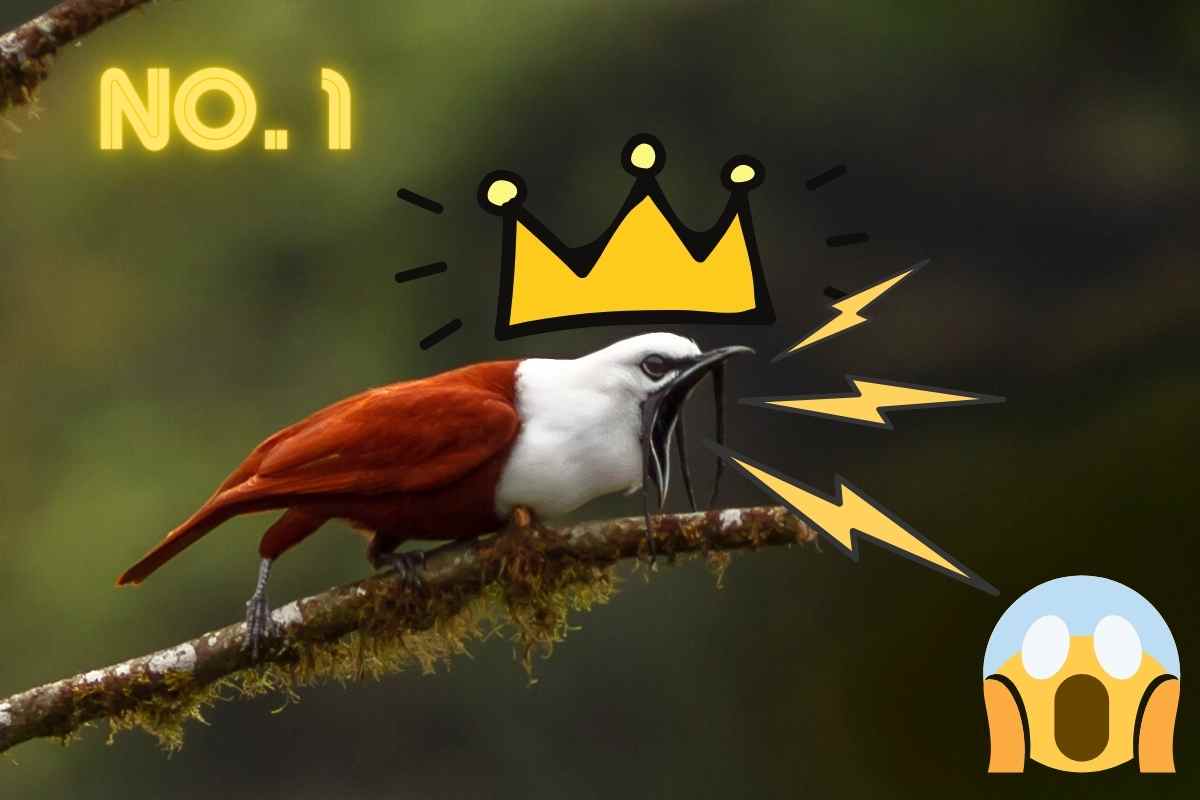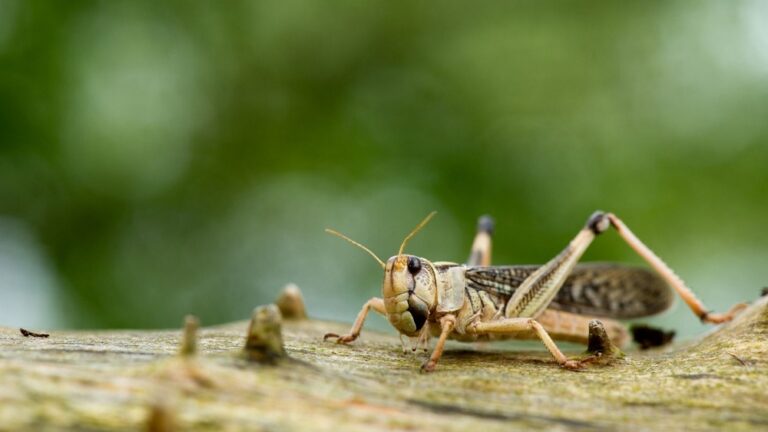The Noisiest Bird In The World (up to 125 db!)
Last Updated on June 10, 2023 by Shu
Imagine strolling through the Amazon rainforest, surrounded by a symphony of nature’s melodies, when suddenly an ear-splitting sound pierces the air. You’ve just encountered the noisiest bird in the world: the White Bellbird!
Sporting a distinctive call that can reach up to 125 decibels ever recorded (comparable to a loud rock concert), this remarkable creature has captivated ornithologists and bird enthusiasts alike.

Read on as we delve into what makes these unique birds so incredibly loud, their role in their ecosystem and how they compare to other noisy avian species around our planet.
Meet The Loudest Bird – The White Bellbird
Do you know the White Bellbird is the loudest bird in the world with a call that can reach up to an ear-splitting 125 decibels? Their loudest call is louder than a rock concert or chainsaw.
What Makes The White Bellbird So Loud?
The extraordinary loudness of this bird can be attributed to its unique vocal structure and an unusually large wattle. Research published in Current Biology found that their syrinx, the bird equivalent of a larynx, has distinct features that enable it to produce sounds at incredibly high decibel ranges.
One fascinating example highlighting just how deafening these birds can be occurred during field research conducted by ornithologists Mario Cohn-Haft and Jeffrey Podos in South America’s Amazon rainforest.
Where Can It Be Found?
The white bellbird lives in the mountains of South America. These regions are known for Amazonian diverse wildlife and vibrant ecosystems. This species shares its clan with cocks-of-the-rock, umbrellabirds, and screaming piha, which makesthese regions popular destinations for nature enthusiasts and birdwatchers alike.
While the male white bellbird makes loud calls that make it easy to locate, spotting this elusive bird can still prove to be a challenge. Its preferred habitat consists of dense forests with tall trees where it perches high up to belt out its mating call.
Why Do White Bellbirds Make Noise So Loud?
Interestingly, their loud call serves a crucial role in courtship and mating behavior, as well as communication within its ecosystem.
Vocalize Courtship And Mating Behavior
Their deafening call plays a crucial role in its courtship and mating behavior. During the breeding season, male birds position themselves high up on tree branches or emergent snags and sing their distinctive calls for when a female nearby.
The loud courtship display is not just for attracting a mate but also acts as a kind of audio GPS system that helps direct the female towards her partner in dense forest foliage.
Vocalization In Its Ecosystem
Plus, the loud call isn’t just for show; it plays a vital role in its ecosystem. The bird’s deafening call can be heard from miles away, alerting other birds to the presence of predators.
By doing so, the White Bellbird helps protect the bird community and maintains balance within its habitat.
This powerful display also serves as an indicator of a healthy ecosystem. As research shows that noise pollution from human activities disrupts animal communication and breeding patterns, including those of birds like the White Bellbird.
Cultural Significance
Noisy birds such as the White Bellbird have captured the attention and admiration of people all over the world. In many cultures, bird songs are associated with themes such as love, freedom, or joy.
Indigenous peoples in South America, for instance, incorporate bird-inspired designs and motifs into their crafts and art forms.
Moreover, avian communication tells us more about how animals interact with each other and with their environment. Scientists study bird calls to understand mating patterns, territorial behavior, predator warnings, and other aspects of animal behavior that can inform our understanding of evolutionary biology.
Other Loud Pet Birds Around The World
Cockatoo
Cockatoos are known for their loud screeches, making them one of the loudest birds in the world. Their sound can often be heard from a distance of more than a mile away. The sound produced by Cockatoos can be compared to a mixture of screaming, squawking, and whistling.
They use these vocalizations to communicate with each other, establish territories, and attract mates. Some Cockatoo species, such as the Sulphur-crested and Moluccan, are known to be louder than others. These birds can produce sounds of up to 120 decibels, which is equivalent to the sound of a chainsaw or a rock concert.
Eclectus Parrot
Eclectus are known for their vibrant feathers and playful personalities, but one of their signature traits that can make them both endearing and challenging is their volume. They can range in volume from moderate to very loud, depending on their individual temperament and environmental stimuli.
In their natural habitat, males often vocalize loudly to establish their territory and attract mates. This instinct remains strong in pet Eclectus, who may also use their voice to communicate with their owners or other birds. Some individuals may be more talkative than others, and their vocalizations can vary from chirping and whistling to high-pitched screeching and squawking.
Sun Conure
Sun conures are small birds and also a type of pet bird. Their volume level can vary depending on a number of factors. Generally, these birds are known to have a relatively loud noise, especially when compared to other small parrots.
In fact, Conures are notoriously chatty birds and can be heard squawking and chirping throughout the day (similar to budgies). The volume of a Conure’s voice can also be influenced by their level of excitement or agitation. When they are happy and content, their vocalizations are likely to be more subdued. However, when they are feeling anxious or threatened, their calls can become very loud and intense.
Cockatiel
Cockatiels are popular pets, generally known to be quieter birds than their larger parrot cousins. However, they are still capable of producing loud sounds when they want to communicate.
A cockatiel’s vocal range varies from soft chirps and whistles to loud screeches. The volume of their sound depends on their mood and the situation they are in. For instance, if a cockatiel wants attention or is feeling territorial, it may make a loud screeching sound to warn intruders or attract its owner’s attention. On the other hand, if a cockatiel is happy or content, it may produce softer sounds such as high whistles and warbles.
Conclusion
In conclusion, the White Bellbird is truly a remarkable creature. Its ear-splitting call makes it one of the loudest birds in the world and sets it apart from other avian species.
The mating call, though deafening, serves an important purpose in its ecosystem and helps attract potential mates during breeding season. We must appreciate and protect these noisy birds and their habitat as they face threats from deforestation, climate change, pollution, hunting, and poaching.
By taking small steps like supporting conservation efforts and respecting nature’s wonders, we can help preserve the noisiest creatures on earth for generations to come.
More Animal Facts
- Interesting Animal Facts About Deer
- Interesting Animal Facts About Axolotls
- Interesting Animal Facts About Eagles
- Interesting Animal Facts About Bears
- Interesting Animal Facts About Hyenas
- Interesting Animal Facts About Leopards
- Interesting Facts About Dik Dik
- Interesting Animal Facts About Crocodiles






